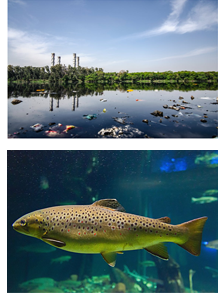Introduction
 Contamination of freshwater ecosystems originates from many sources, but the majority of pollutants that end up in water bodies are of anthropogenic origin (man-made). Several classes of pollutants are contributing to water contamination and have been studied for decades: organic waste, plant nutrients, inorganic chemicals and minerals. However, another class of contaminants is not extensively studied and is termed “emerging pollutants”. These substances are not yet regulated but may be of environmental or human health concern, and they include antibiotics, drugs, industrial additives, microbeads, microplastics and hormones. The focus of this research project was to tackle the pollution of aquatic ecosystems with one specific class of hormones - progestins. Progestins (also called gestagens, progestogens) are frequently used in birth control pills, cancer therapy and animal husbandry. After use, progestins are excreted from the human or animal body, and they end up in the water since wastewater treatment plants cannot completely degrade them. If concentrations increase in the water, progestins can cause deleterious effects on aquatic fauna and in the first place, they negatively affect the endocrine system of animals. This phenomenon is called “endocrine disruption” since progestins modulate and ultimately disturb the normal hormonal status of the animal. They may cause changes in many organs of fish, but the effects are most severe in endocrine glands, gonads and liver. Apart from fish, all other aquatic animals are at risk, as well as complete ecosystems (not only freshwater, but also marine ecosystems). In previous experiments, entire fish populations collapsed if they were exposed to extremely low concentrations of hormones (6 ng/L) for three years. Those concentrations are usually found in rivers across the world, including Europe. Furthermore, the presence of hormones in drinking water poses a significant risk to the human population.
Contamination of freshwater ecosystems originates from many sources, but the majority of pollutants that end up in water bodies are of anthropogenic origin (man-made). Several classes of pollutants are contributing to water contamination and have been studied for decades: organic waste, plant nutrients, inorganic chemicals and minerals. However, another class of contaminants is not extensively studied and is termed “emerging pollutants”. These substances are not yet regulated but may be of environmental or human health concern, and they include antibiotics, drugs, industrial additives, microbeads, microplastics and hormones. The focus of this research project was to tackle the pollution of aquatic ecosystems with one specific class of hormones - progestins. Progestins (also called gestagens, progestogens) are frequently used in birth control pills, cancer therapy and animal husbandry. After use, progestins are excreted from the human or animal body, and they end up in the water since wastewater treatment plants cannot completely degrade them. If concentrations increase in the water, progestins can cause deleterious effects on aquatic fauna and in the first place, they negatively affect the endocrine system of animals. This phenomenon is called “endocrine disruption” since progestins modulate and ultimately disturb the normal hormonal status of the animal. They may cause changes in many organs of fish, but the effects are most severe in endocrine glands, gonads and liver. Apart from fish, all other aquatic animals are at risk, as well as complete ecosystems (not only freshwater, but also marine ecosystems). In previous experiments, entire fish populations collapsed if they were exposed to extremely low concentrations of hormones (6 ng/L) for three years. Those concentrations are usually found in rivers across the world, including Europe. Furthermore, the presence of hormones in drinking water poses a significant risk to the human population.

Objective of the project
The main objective of the SPHEROTOX project was to study effects of two progestins (levonorgestrel and megestrol-acetate), as well as 17α-ethynylestradiol (estrogen) and their binary mixture on the liver of brown trout, an indigenous species for the European continent. Moreover, we also wanted to assess the impact of one key element of climate change on brown trout by exposing them to hormones at two different temperatures: 18 and 21°C. Fish are poikilothermic animals, and their body temperature depends on the water temperature in which they live. We hypothesised that at a higher temperature, the toxicity of endocrine disruptors would have a different impact compared to a lower temperature. Instead of conducting toxicological assays in vivo, we used three-dimensional cellular agglomerations called “spheroids” in vitro. The advantage of using spheroids compared to routine 2D cell cultures is their ability to more closely mimic conditions in real organs. Spheroids have specific microenvironments, cell-to-cell interactions, and metabolism more similar to in vivo. Using this technique, we managed to culture spheroids and exposed them to hormones, either as a single chemical or in mixtures. These are more relevant to environmental pollution as pollutants in the water are found in complex mixtures, which have additional adverse effects on aquatic animals.
